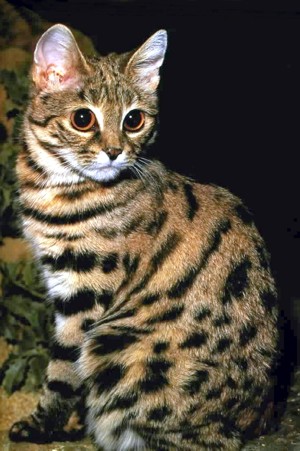|
Weight: 2.5-4.5 pounds´┐Ż
Head/Body: 14-18 inches´┐Ż
Tail: 6-7 inches´┐Ż
Subspecies: 2
The smallest of all the species of cats, the Black-footed cat is indeed one of the most fascinating. Also known as the ant-hill tiger, or little spotted cat, this is the smallest of the African felids. It is reputed to be exceptionally fierce. They do not require a water source, since they receive most if not all their moisture needs from their prey. They also have higher energy requirements than larger African wild cats.
They are slightly bigger than the Asian rusty spotted cat, and the South American kodkod (similar to a very small domestic cat). Unlike most spotted cats, the black-footed cat's pink skin contains no pigmentation. With a shoulder height of approximately 22cm and a body length of 50cm, the average male weighs in at about 2.2kg. However, the female often weighs as little as 1.5kg, and as such can be classified as the smallest of all wild cats.
The cat has a large broad head in proportion to its small body, and its coat color varies from light sandy brown to reddish brown. It is covered with dark spotted patches which sometimes combine into broken stripes. The legs of the black-footed cat are barred with dark horizontal stripes, and the tail is broken with dark rings which terminates at the black tip. The pads of its feet are black and are with long black hairs, which give the small felid its name, and are used to protect its feet from the heat of the semi-desert habitat.
F. n. nigripes, displaying a paler coat, is found in the northern parts of its range (Botswana, Namibia and Angola). F. n. thomasi, having a darker coat, is native to the Eastern Cape Provence and the southern parts of South Africa. The black-footed cat is restricted to the arid lands of Southern Africa. It is typically associated with open, sandy, grassy habitats with sparse shrub and tree cover, such as the Kalahari and Karoo regions. Long grass with high rodent and bird densities is the optimal habitat.
Their diet consists of shrews, gerbils, hares, lizards and beetles. In one study, 57% of stomachs contained murid or mouse-like rodents, and 43% contained arachnids. Highly opportunistic, black-footed cats will take any prey they can overpower. Uneaten food is cached for later. They have been observed to scavenge springbok carcasses and take birds in the air. Black-footed cats are regularly reported to hang onto the throats of sheep until they pierce their jugular veins! While eating, they empty the contents of their prey´┐Żs stomachs and intestines, pulling them through their teeth to squeeze the contents out. They will drink if water is available but they usually get all the moisture they require from their prey. It has been reported that they will also eat grass.
These cats have a gestation period of about 65 days. Litters range from one to three kittens. The kittens first leave their burrow in about 30 days, and shortly thereafter, begin eating solid food. Although kittens grow fairly quickly, they do not reach maturity until about a year and a half.
Black-footed cats are described as a rare species by many experts, whilst other reports suggest that they are common in parts of their range. Although not generally threatened by hunting, pest control by local farmers may well present a problem. Poison and traps, indiscriminately laid for the African Wildcat and Jackal, are reported to be affecting black-footed cats in certain areas. The black-footed cat is listed as 'Least Concern' in the IUCN Red Book of Endangered Species and is listed in CITES Appendix I.

|



